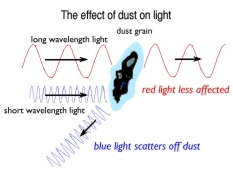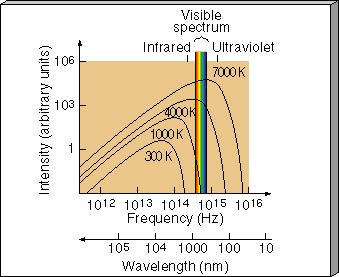Surveying the Sky in the Infrared
Over the last 50 years astronomers have been able to chart the entire sky at visual wavelengths. A large volume of old glass photographic plates were successfully taken of both the northern and southern skies, and prints have been made of these plates and made available to astronomers all over the world. (A digitized online version is now even available.) Such a survey has been an invaluable tool for astronomy, and gets regular use every day. Currently, a more modern, more sensitive version of the Palomar Observatory Sky Survey, using digital optical detectors on northern hemisphere telescopes, is complete.Our Solar System is part of a vast ensemble of billions of stars, known as the Milky Way Galaxy. Our Galaxy is a large flat disk of stars and gas, orbiting around a central, more concentrated bulge of stars. We orbit, along with the Sun, about two-thirds of the way out from the Galaxy's center. Below is how we visually see the rest of our Galaxy from Earth (click on the image for an expanded view). The large flat disk is seen as the Galactic Plane; the Galactic Bulge is the brightest concentration toward the center of the image.
 | Our view of the Milky Way Galaxy in the visible | (Click on the image for an expanded view) |
 What you may notice in the image are the long and patchy "lanes" of darkness
amid the bright starlight. These dark regions are not due to a lack of stars
in those particular directions. Unfortunately, along with the stars and gas
orbiting the center of our Galaxy, clouds of
dust particles also orbit
the Galaxy. These cold, dense clouds of dust act much like dust clouds in
a swirling wind storm here on Earth, obscuring your view of what's off in
the distance, as you try to look through them.
The size of many of the individual grains of space dust are
about the same as the wavelength for blue light (or, about
the size of individual grains of chalk dust on a chalkboard eraser). See the
figure at left. When blue light waves
encounter a dust grain, the light "sees" the grain as a large obstacle, and
scatters off the grain in a random direction, as a ping-pong ball would off
a bowling ball. Redder light waves are less affected by the dust, since
the light wavelength is about the same size, or greater, than the size of
the grain. This means that much of
the blue light emitted from stars in our Galaxy behind the dust clouds gets
scattered away from our direct view, making the stars, as we see them
through the clouds (if we can!), look
redder and
dimmer than they actually are.
What you may notice in the image are the long and patchy "lanes" of darkness
amid the bright starlight. These dark regions are not due to a lack of stars
in those particular directions. Unfortunately, along with the stars and gas
orbiting the center of our Galaxy, clouds of
dust particles also orbit
the Galaxy. These cold, dense clouds of dust act much like dust clouds in
a swirling wind storm here on Earth, obscuring your view of what's off in
the distance, as you try to look through them.
The size of many of the individual grains of space dust are
about the same as the wavelength for blue light (or, about
the size of individual grains of chalk dust on a chalkboard eraser). See the
figure at left. When blue light waves
encounter a dust grain, the light "sees" the grain as a large obstacle, and
scatters off the grain in a random direction, as a ping-pong ball would off
a bowling ball. Redder light waves are less affected by the dust, since
the light wavelength is about the same size, or greater, than the size of
the grain. This means that much of
the blue light emitted from stars in our Galaxy behind the dust clouds gets
scattered away from our direct view, making the stars, as we see them
through the clouds (if we can!), look
redder and
dimmer than they actually are.
 Additionally, not all objects in the sky have the same temperature. As we
said earlier, all objects with some temperature above absolute zero will
radiate in the infrared. See the figure at right.
Hotter objects emit more light at shorter
wavelengths, such as visible light or even higher-energy light, such as
ultraviolet, than cooler
objects, which can emit most of their light in the infrared. Our bodies,
near 300 degrees Kelvin (300 K, in the figure at right) for
instance, emit almost all of their light in the infrared, with negligible
amounts of visible light, and even far less ultraviolet!!
Some stars and star-like
objects are so cool, therefore, that they emit most of their light in the
infrared, making them hard to see in the visible.
Additionally, not all objects in the sky have the same temperature. As we
said earlier, all objects with some temperature above absolute zero will
radiate in the infrared. See the figure at right.
Hotter objects emit more light at shorter
wavelengths, such as visible light or even higher-energy light, such as
ultraviolet, than cooler
objects, which can emit most of their light in the infrared. Our bodies,
near 300 degrees Kelvin (300 K, in the figure at right) for
instance, emit almost all of their light in the infrared, with negligible
amounts of visible light, and even far less ultraviolet!!
Some stars and star-like
objects are so cool, therefore, that they emit most of their light in the
infrared, making them hard to see in the visible.
This all means that, when we look at our Galaxy, in particular, in visible light only, we are not seeing everything that's out there! Much of the Galaxy remains hidden from our view. However, looking in space in the infrared allows us to penetrate much of the obscuring dust, allowing us to see more of the Universe! Waves of infrared light in space are longer than the size of the dust grains, and infrared light waves therefore travel onward relatively unimpeded. That means the infrared light can make its way to Earth much more easily than, say, visible light.
As a result, we see many more stars, nebulae, and
galaxies all over the sky in the infrared. In order to see the entire sky in
the infrared, astronomers need to survey the heavens in an organized way,
with modern telescopes and infrared-sensitive detectors.
Back to What is Infrared?
On to 2MASS: The All Sky Infrared Survey
Return to the 2MASS Home Page